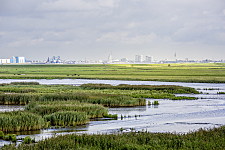Demand side management

Climate change is resulting in extreme weather events. In addition to sudden bouts of high rainfall, there are also more and more very long periods without rain. This is making it even more important for the water management sector to have reliable and readily available drainage technology. This both serves land management and is a key aspect of protecting the population.
In the context of the Sluice Drainage Demand Side Management project, EnergieSynergie GmbH is carrying out a feasibility study for more energy-efficient, centrally monitored sluice drainage. By ensuring that energy is only used when needed and by using renewable energy sources, drainage equipment is to be made more sustainable and safer in future.
In addition to extreme weather events like sudden bouts of heavy rainfall, climate change is also resulting in more and more extremely long periods without precipitation. Sluices need to be operated proactively if the land and the population are to be protected. Most of the sluices are not monitored centrally. If a pump fails, an area may be flooded by heavy rainfall.
New concepts are needed for active drainage and a smart water management system which cuts carbon emissions and conserves resources. There is a pressing need for access to reliable and readily available technology and equipment.
As part of the Sluice Drainage Demand Side Management PFAU project, EnergieSynergie GmbH is working on a feasibility study into needs-based energy use and the deployment of renewable energy so that drainage systems can be operated more sustainably in future. One of the aims is to develop operating instructions for sluices which reduce the environmental impact as far as possible by obtaining electricity from wind and photovoltaics and to enable sluices to better serve the needs of the electricity grid.
Another goal is to have central monitoring of the sluices. In future, mobile data communication will make it possible to transmit the data from the meters and signals from pumps and other equipment, store them in a database and visualise them on a website. This will mean that the pumps can be monitored centrally, faults can be noted without delay, and further action can be taken, e.g. repairs and maintenance work. As a way to improve existing remote monitoring, for example, the volumes of water in the sluice can be linked to rainfall forecasts so that appropriate amounts of water can be stored. Also, the sluices can be supplied with electricity from wind turbines, and the smart linkage of storage and sluice volumes with rainfall forecasts and needs-based pumping can leverage potential for reduced carbon emissions.
The study aims to produce a modular, environmentally friendly and climate-friendly concept. Another priority is to highlight the advantages of direct and indirect reductions in the environmental impact.
The project is being funded from the programme to promote applied environmental technologies (PFAU) run by Bremen’s Senator for Climate Action, Environment, Mobility, Urban Development and Housing as well as from the European Regional Development Fund (ERDF).

This project focus on climate an is supported by our hero Eco